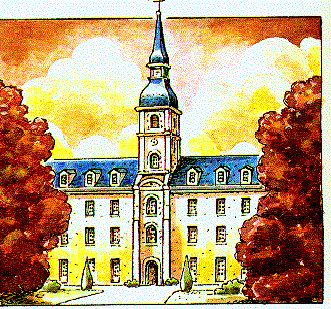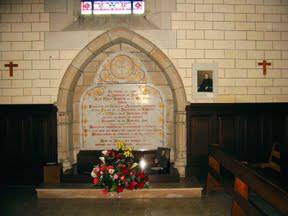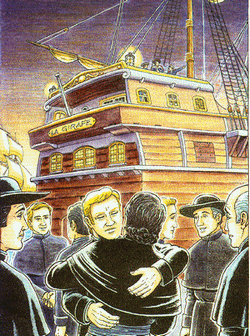Animated by the Holy Spirit and encouraged by their mutual understanding, they redoubled their efforts to develop their project. The first profession of the vow of obedience was made during the retreat at Auray on September 15, 1820. The nascent Congregation of the Brothers of Christian Instruction grew rapidly. In November 1824, thanks to an acquisition by Fr. Deshayes, Plöermel became the motherhouse of the Congregation.
In spite of their hasty preparation and of the precarious conditions in which they lived,the Brothers emulated the zeal of their Founders as they carried the light of the Gospel and the rudiments of knowledge to the youth of the impoverished regions. With the courage of true missionaries, many crossed the oceans to open the hearts of the people of the West Indies and of Africa to the liberating Word of Christ the Savior.
Assured of the future of the Congregation to which he had given his all, surrounded by the love of his 852 Brothers and of the Daughters of Providence of Saint-Brieuc, held in veneration by countless children and parents, Jean Marie de la Mennais still considered his work unfinished: “My son,” he uttered to his successor, Brother Cyprien, shortly before his death, “complete my work”. Fr. de la Mennais died at Plöermel on December 26, 1860.
Faithful to the intentions of their saintly Founders, the Brothers continue to provide Christian instruction and education in their schools. The missionary apostolate, initiated as early as 1838 in Guadaloupe, was extended to Martinique, Senegal, French Guyana, St. Pierre-et-Miquelon and Tahiti during the Founder’s lifetime, and to the Marquesas Islands and to Haiti shortly thereafter. When the policies of the French government resulted in the Brothers’ expulsion from most of these areas, their apostolic zeal led them to Canada. Meanwhile, the Congregation had been strengthened by the incorporation of two smaller groups, Bishop de la Croix d’Azolette’s Brothers of Gascony, and Father Charles-Auguste Duguey’s Brothers of Saint Marie de Tinchebray, in 1880.
In spite of its official suppression in France in 1903, resulting in the loss of more than half of its 2200 members and all of its property, the Congregation kept faith with its destiny. It persisted in France through the willingness of many to live and work clandestinely in constant uncertainty and severe deprivation. It was temporarily planted in Bulgaria, Turkey and Egypt. It flourished in Canada from 1886 onwards, as well as in Spain, England, the United States and Italy after the turn of the century.
Later, several of these countries, especially Canada, sent their own sons, Brothers of Christian Instruction, to help in existing missions or to establish new ones in Africa: Uganda, Kenya, Tanzania, the Seychelles Islands, Rwanda, Burundi, and Congo, as well as in Japan, the Philippines and Alaska. Spain sent Brothers to Argentina, Uruguay, Chile and Bolivia. Meanwhile the French Brothers returned to Senegal and the Marquesas and established new missions in the Ivory Coast, Togo and Benin. In 2000, France and Spain joined forces to send four Brothers to Indonesia.
The work of evangelization, carried on in a variety of settings, was greatly facilitated because the Founders, from the very beginning, established the Brothers as a religious congregation. As it expanded, successive general chapters completed the organization and insisted on the basic unity of the religious life and the apostolate. Adapting to the changing times, the Brothers understood that the impact of their work called for more advanced academic and professional preparation and a deeper spiritual life sustained by more serious scriptural and theological studies, hence, for a more solid initial formation and ongoing opportunities for personal development.
Thus, the religious and apostolic heritage of the Founders, authenticated by papal approval in 1891 and 1910, is preserved and transmitted today. In a changing world, the Brothers continue to devote themselves generously in the service of youth, attentive to the aspirations of their contemporaries, but always in reference to Christ, the supreme rule of their lives.



